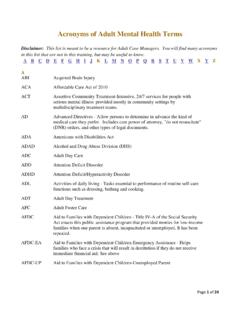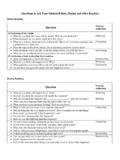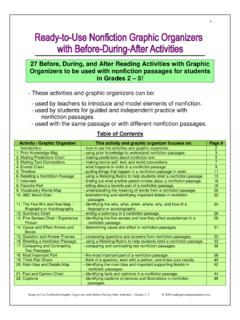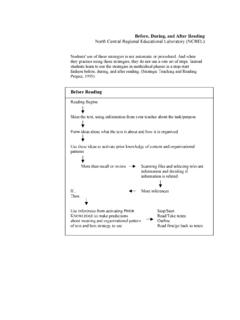Transcription of Guidelines before, during and after the visit. - Pathlore LMS
1 Guidelines before , during and after the visit. Safety of the crisis staff and recipients are of utmost importance with each community visit. Safety issues will be considered in the following three sections; before the Visit, during the Visit, and after the Visit. before the Visit: Is it an Emergency or a Crisis? An emergency is acute and requires an immediate response by one of the following interventions. Call 911 for: Medical emergencies. Possible overdose or other suicide in progress. Violence in progress. Cases where the crisis responder cannot get necessary information on the phone from the person or referral source due to communication barriers. Danger to self or others is suspected. Violent crime or victimization has occurred. If the caller is unable to make the 911 call, the crisis responder will need to ask for the address (including apartment number) and phone number and immediately call 911. A crisis, on the other hand, may require an immediate crisis outreach visit or may best be handled by the persons' own provider if the provider can be reached by the crisis staff for consultation.
2 In most instances, the person can participate in planning for their safety and setting the plan rather than the crisis staff taking charge. Medical issues need to be referred to medical providers. It is not the role of the crisis staff to evaluate medical symptoms or give medical advice. If the caller (potential recipient or referral source) either calls about medical concerns or, as the initial phone call proceeds, reports medical symptoms (other than minor colds, sore throats, headaches etc.), the crisis responder will quickly redirect the caller to focus on the possible medical intervention needed ( caller to contact own health care provider or go to Urgent Care or Emergency Room). during the Phone Call 1. At times, the family member or professional calling may just need to consult and consider options. As more information is obtained, the crisis responder may recommend they call 911. 2. The crisis responder needs to move from crisis intervention to emergency mode quickly depending on the information received during the initial phone call.
3 3. The caller usually starts with current problem, so the crisis responder needs to give the caller a chance to talk and vent, but IMMEDIATELY start listening for possible danger to self/others. 4. The crisis responder needs to direct the conversation by asking direct questions to get the needed information. Is there a diagnosis? Is there a history of danger to self/others? Are there weapons? Always ask if anyone else is in the home. 5. Keep in mind that, while information from referral sources is important, it's important to look with an unbiased eye. The provider or family member may see current crisis as more of the same and may suggest a particular outcome ( , medication or hospitalization) or may feel the person is being manipulative because they themselves are feeling overwhelmed. 6. Is the person willing to accept a crisis outreach visit? If not, is there another intervention he/she will accept, that is seeing own providers or a referral to the Emergency Room?
4 7. Consult with supervisor or other crisis staff, if unsure who should go on the visit (crisis staff, crisis staff and provider, or crisis staff and police). This is an important decision based on what the crisis responder hopes to accomplish at the visit and what safety concerns exist. It is important not to overwhelm the person with too many people, two staff plus police if needed, is usually best. It's always helpful for both person and staff if someone who knows the person can be present. 8. Evaluate the risks vs. benefits of asking police to accompany you on the visit. Despite what the situation may sound like on the initial phone call, keep in mind that it may look quite different at the time of the visit. Depending on the person's history, approaching with police may escalate the situation. On the other hand, if it becomes clear that police will be needed, the crisis responder can always leave and return later with police.
5 9. Always meet police where weapons are involved or there is a history of assault, threats of assault, possible completed suicide and in cases where community providers or crisis responders are unable to get into the person's home and a visit is necessary due to possible danger to self/others. 10. If the initial call is from a mental health professional (psychiatrist, therapist, etc.) and that person has already determined that the client is at high risk and holdable, but has been unable to reach the client on the phone and is calling crisis program for a CHECK WELFARE visit, that professional should be advised to call 911, as time may be of the essence and that professional has the clinical information from their most recent contact. Police response to CHECK WELFARE calls is much quicker and if they need to gain entry they can do so immediately. Also, many people are unwilling to answer the door for a stranger at their door but will open the door for police.
6 11. If planning to meet another crisis responder or provider on site, it is best to provide a report to that person on the phone before arriving on site. There may not be an opportunity at the scene. Determine who will take the lead in the intervention and communicate that plan. 12. If planning to meet police or provider at home of person and they are not expecting the visit, plan to meet at end of block to discuss case/issues prior to arrival at the address, rather than gathering in front of the address. 13. If the provider or police are requesting a visit and determine it is best not to tell the person that crisis responder is coming, crisis responder will go with the provider or police without client's agreement. Again, if discussion is necessary, plan to meet away from the address in these cases. 14. Follow crisis program policy regarding leaving information at the office regarding your destination, who you are going with, etc.
7 15. Follow crisis program policy regarding snow and other weather emergencies. during the Visit 1. Get good directions and have a cell phone with you. Always be aware when driving. If someone appears to be following you, do not continue to the destination. Drive to nearest police station or to the ER. If in a rural area it might not be expedient to get to the above. Proceed to an open gas station, open restaurant or residence of someone you know. 2. Do not stop if flagged down by someone. If they appear to need assistance, call 911 and report situation and location. 3. When arriving at the address, drive slowly and notice if there are any situations present such as people loitering or people intoxicated, dogs in the front yard or at entrance. You may want to call the person you are visiting and ask them to come to the front door to meet you or, you may need to visit at another time or with police. If arriving after dark, it is always advisable to call from your car and ask staff or family member to come to the door.
8 4. Prior to and when entering the home do you notice any strange smells? Methadone labs often present a strong ammonia smell similar to cat urine. Upon entering the home, notice people who are present and ask people their names and their relationship to the person you are visiting if unsure. When possible, meet with recipient in living area rather than bed room or kitchen. Keep in mind that you want to be able to leave quickly if necessary. You want to avoid easy access to kitchen knives or sports equipment or potential weapons. 5. Keep your shoes on unless it seems appropriate and safe to remove them. State clearly who you are, your agency name and why you are there, with emphasis on your intent to help the person. 6. If the person becomes very loud and agitated and requests that you leave, immediately prepare to do so. Offer to leave your phone number or that of another agency that may be helpful. If you do need to evaluate the person's risk of danger to self/others or ability to care for self, you may need to return with police or another individual the person is willing to see such as a social worker or family member.
9 7. If a person's behavior is inappropriate or the person or others in the home are intoxicated or you suspect other chemical use, leave the home! Consult with your supervisor regarding the need to intervene or schedule a visit at another time. 8. If you determine that the person meets criteria for a Transportation Hold, plan with co crisis responder if it is safe for one responder to stay with the person as the other steps outside the door or to another area to call 911. It may be necessary to for both to leave, meet police outside and return with police. In most cases, it is not advisable to tell the person you are placing them on a Transportation Hold until police are present. 9. Once police are on the scene, provide the officers with as much information about the person and the situation, and what you think will be the best plan. The officers may be willing to stand by while you intervene, or they may prefer to take the lead.
10 In any case, ensure that one responder speaks to the person at a time. If officers are dealing with the person, crisis responders may want to use that opportunity to check the scene for any medications, alcohol, etc., or signs of a possible overdose. If possible, it is best to send medications with the paramedics. You may observe the surroundings to see if they are capable of providing for themselves and other documentation of the person's ability or inability to manage safely in the residence. 10. If officers instruct crisis responders to leave the room or area, do so immediately, as officers may be aware of a safety concern that you are unaware of such as the presence of weapons or other dangers. 11. Remain alert to surroundings as you are walking to your car and always lock car immediately. after the Visit 1. If an individual is transported to the ER, call team leader with report including any safety concerns ( person struggled with police, intoxicated, history of assault, weapons etc.)











